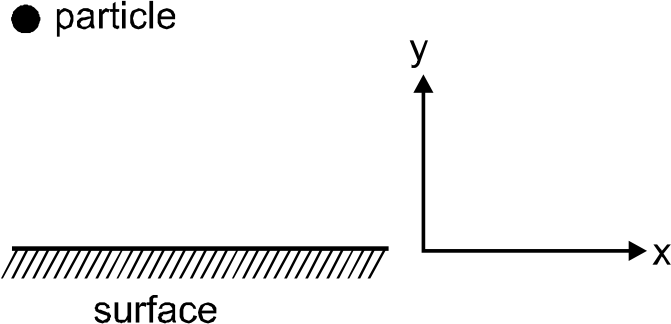A particle of mass m moving with a velocity (3ˆi+2ˆj)ms−1 collides with a stationary body of mass M and finally moves with a velocity (−2ˆi+ˆj)ms−1.If mM=113 is then
the impulse received by Mis m(ˆi+5ˆj)
the velocity of the Mis (ˆi+5ˆj)
the coefficient of restitution is 2213
All of the above are correct
The correct Answer is:B
Impulse received by m
J=m(vf−vi)=m(−2ˆi+ˆj−3ˆi−2ˆj)=m(−5ˆi−ˆj)
and impulse received by M=−J=m(5ˆi+ˆj)
(b) Mv=m(5ˆi+ˆj) or v=mM(5ˆi+ˆj)=113(5ˆi+ˆj)
Similar Questions
A particle of mass m moving with a velocity (3ˆi+2ˆj)ms−1 collides with another body of mass M and finally moves with velocity (−2ˆi+ˆj)ms−1. Then during the collision
View SolutionA particle of mass m moving with a velocity (3ˆi+2ˆj)ms−1 collides with another body of mass M and finally moves with velocity (−2ˆi+ˆj)ms−1. Then during the collision
View Solution
Knowledge Check
- Question 1 - Select One
A partical of mass 'm' moving with a velocity (3ˆi+2ˆj)m/s collides with statinary mass 'M' and finally 'm' moves with a velocity (−2ˆi+ˆj)m/s if mM=113 the velocity of the M after collision is?
A(5ˆi+ˆj)m/sB(5ˆi−ˆj)m/sC(5ˆi13−ˆj13)m/sD(5ˆi13+ˆj13)m/s - Question 2 - Select One
A particle of mass m1 moving with a velocity of 5 ms−1 collides head on with a stationary particle of mass m2. After collision both the particle move with a common velocity of 4ms−1then the value of m1/m2is :
A4:1B2:1C1:8D1:1 - Question 3 - Select One
A body of mass 3 kg moving with a velocity (2ˆi+3ˆj+3ˆk) m/s collides with another body of mass 4 kg moving with a velocity (3ˆi+2ˆj−3ˆk) m/s. The two bodies stick together after collision. The velocity of the composite body is
A17(4ˆi+6ˆj−3ˆk)B17(18ˆi+17ˆj−3ˆk)C17(6ˆi+4ˆj−6ˆk)D17(9ˆi+8ˆj−6ˆk)
A particle of mass 'm' moving with a velocity (3ˆi+2ˆj)m/s collides with stationary mass 'M' and finally 'm' moves with a velocity (−2ˆi+ˆj)m/s if mM=113 the velocity of the M after collision is?
View SolutionA body of mass m moving with velocity 3km/h collides with a body of mass 2m at rest. Now, the combined mass starts to move with a velocity
View SolutionA body of mass 3 kg moving with a velocity (2ˆi+3ˆj+3ˆk) m/s collides with another body of mass 4 kg moving with a velocity (3ˆi+2ˆj−3ˆk) m/s. The two bodies stick together after collision. The velocity of the composite body is
View SolutionA body of mass m moving with velocity 3km/h collides with a body of mass 2m at rest. Now, the coalesced mass starts to move with a velocity
View SolutionA particle moving with velocity (2ˆi−3ˆj) m/s collides with a surface at rest in xz–plane as shown in figure and moves with velocity (2ˆi+2ˆj) m/s after collision. Then coefficient of restitution is :
 View Solution
View Solution

